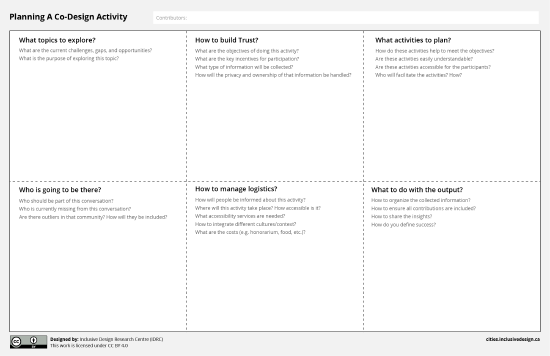Resources
PLANNING YOUR CO-DESIGN ACTIVITY
Including unique and diverse needs in the co-design process is an effective way to ensure our design adapts to a broader range of needs. However, involving citizens in a co-design process may seem expensive, time consuming, and overwhelming. This template provides a list of items to consider when planning, executing, facilitating, and reporting a co-design process based on your goals, context, and resources. It can be used in any format or order, and adapted for your own processes by adding, removing, and modifying its content. If you have any comments regarding this template or the following resources, please send us an email via cities@idrc.ocadu.ca.
Download the Co-design template:
PDF,
Google Doc,
Word,
Audio page 1,
Audio page 2,
Braille 3D print files part 1 (ZIP)
Braille 3D print files part 2 (ZIP)
A list of resources is provided to elaborate on each section of the template. These resources include best practices, reflections of our own co-design experiences, and practical tools to plan a co-design process. We encourage all those involved in co-design to share their perspectives, methods, challenges, and learnings by completing this form and contributing to this public resource.
RESOURCE TYPES
- Perspectives
- Reflections
- Tools
What topics to explore?
Identifying project scope in collaboration with the community helps to incorporate specific needs and contexts.
Read more
Read more
Defining the purpose of exploring a topic facilitates the development of a co-design process.
Read more
Read more
Who is going to be there?
Actively integrating people at the margins helps to develop ideas that can benefit everyone.
Read more
Read more
It is challenging to create an environment where participants with diverse needs can collaborate.
Read more
Read more
Engaging marginalized groups in a co-design process is difficult due to past mistreatments.
Read more
Read more
Understanding who is currently excluded from the process helps to develop new ways of engagement.
Read more
Read more
How to build trust?
It takes humility, respect, and transparency to earn your collaborators and participants trust.
Read more
Read more
To build trust, participants should be clearly informed of their rights and terms of participation.
Read more
Read more
Building lasting relationships requires open mindedness, transparency, and clear negotiation of roles.
Read more
Read more
Contributor license agreements clarify terms of participation and ownership of contributions.
Read more
Read more
Getting participant insight about the process helps to build trust and refine future events.
Read more
Read more
The Arnstein’s ladder of citizen participation helps to assess your community engagement efforts.
Read more
Read more
What activities to plan?
To enable equal participation, activities should be accessible and understandable for all participants.
Read more
Read more
Accessibility of an activity relies on its physical presentation, format, length and use of language.
Read more
Read more
Facilitating a group with different perspectives and needs requires open mindedness and flexibility.
Read more
Read more
This list highlights the items that should be considered when planning a collaborative event.
Read more
Read more
This warm-up activity encourages individuals to engage in a playful and collaborative ideation process.
Read more
Read more
An inclusive city imaginary is a collaborative tool to explore city designs from different perspectives.
Read more
Read more
This tool enables different levels of participation from individual reflections to group discussion.
Read more
Read more
Story puzzle encourages participants to collaborate to put different pieces of a story back together.
Read more
Read more
This tool helps participants to reflect on their urban experiences and identify high/low risk areas.
Read more
Read more
What to do with the output?
Identify the means that enable people to change and expand the end product to fit their needs.
Read more
Read more
Open processes enable greater participation, however, they should protect their participants’ privacy.
Read more
Read more
Inclusion of all ideas was difficult sometimes due to lack of context, limited or non-legible notes.
Read more
Read more
It is essential to openly share the results of co-design events with the participants and the community.
Read more
Read more
How to manage logistics?
Organizing a co-design event includes factors that the team cannot control and should be ready to adapt to.
Read more
Read more
Access guides help to reduce the anxiety of being in a new place and among a group of strangers.
Read more
Read more
A respectful, clear, and well planned invitation is the first step to build trust and engage people.
Read more
Read more
